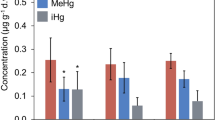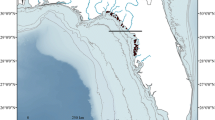Abstract
Radiotracer experiments were designed to study the effect of certain factors on the accumulation and loss of methyl and inorganic mercury in mussels (Mytilus galloprovincialis) and benthic shrimp (Lysmata seticaudata). Methyl mercury was accumulated from both food and water to a greater degree than inorganic mercury by both species. There was a tendency for small mussels to concentrate more mercury than larger individuals, but the reason for this difference remains unclear. A trend towards greater mercury accumulation at higher temperatures was noted for mussels, but the temperature effect was relatively small over a 10 Co range between 8° and 19°C. Methyl mercury residues were eliminated by both species more slowly than those of the inorganic form. Loss from mussels was somewhat more rapid at higher temperatures; however, as in the case of accumulation, the effect of temperature was relatively small. Loss rates for small mussels were not significantly different from those for large individuals. Enhanced methyl mercury elimination was noted for the group of mussels maintained in their natural environment. The more rapid metal turnover in these individuals compared with mussels held in the laboratory was attributed to differences in the availability of natural particulate food matter and, hence, subsequent growth of the animals in the two experimental systems. The observed differences underscore the need for caution in predicting in situ flux of metals such as mercury in certain species based solely on data derived from laboratory experiments.
Similar content being viewed by others
Literature Cited
Bertine, K.K. and E.D. Goldberg: Trace elements in clams, mussels and shrimp. Limnol. Oceanogr. 17, 877–884 (1972)
Boyden, C.R.: Trace element content and body size in molluscs. Nature, Lond. 251, 311–314 (1974)
Cunningham, P.A. and M.R. Tripp: Accumulation, tissue distribution and elimination of 203HgCl2 and CH3 203HgCl in the tissues of the American oyster Crassostrea virginica. Mar. Biol. 31, 321–334 (1975a)
——: Factors affecting the accumulation and removal of mercury from tissues of the American oyster Crassostrea virginica. Mar. Biol. 31, 311–319 (1975b)
De Wolf, P.: Mercury content of mussels from west European coasts. Mar. Pollut. Bull. 6, 61–63 (1975)
Fowler, S.W. and G. Benayoun: Experimental studies on cadmium flux through marine biota. In: Comparative studies of food and environmental contamination, pp 159–178. Vienna: International Atomic Energy Agency 1974
——: Influence of environmental factors on selenium flux in two marine invertebrates. Mar. Biol. 37, 59–68 (1976)
—, M. Heyraud and T.M. Beasley: Experimental studies on plutonium kinetics in marine biota. In: Impacts of nuclear releases into the aquatic environment, pp 157–177. Vienna: International Atomic Energy Agency 1975a
—, J. La Rosa, M. Heyraud and W.C. Renfro: Effect of different radiotracer labelling techniques on radionuclide excretion from marine organisms. Mar. Biol. 30, 297–304 (1975b)
Järvenpää, T., K. Rissanen and J.K. Miettinen: Biological half-time of methyl mercury and inorganic mercury in mussels, 7 pp. Unpublished manuscript, Department of Radiochemistry, University of Helsinki 1975
Kečkeš, S. and J.K. Miettinen: Mercury as a marine pollutant. In: Marine pollution and sea life, pp 276–289. Ed. by M. Ruivo. London: Fishing News (Books) Ltd. 1972
—, B. Ozretić and M. Krajnović: Loss of Zn65 in the mussel Mytilus galloprovincialis. Malacologia 7, 1–6 (1968)
Kopfler, F.: The accumulation of organic and inorganic mercury compounds by the Eastern oyster Crassostrea virginica. Bull. envir. Contam. Toxicol. 11, 275–280 (1974)
Luoma, S.N.: Physiological characteristics of mercury uptake by two estuarine species. Mar. Biol. 41, 269–273 (1977a)
— The dynamics of biologically available mercury in a small estuary. Estuar. cstl mar. Sci. 5, 643–652 (1977b)
Miettinen, J.K., M. Heyraud and S. Kečkeš: Mercury as a hydrospheric pollutant. II. Biological half-time of methyl mercury in four Mediterranean species: a fish, a crab and two molluscs. In: Marine pollution and sea life, pp 295–298. Ed. by M. Ruivo. London: Fishing News (Books) Ltd. 1972
Pentreath, J.: The accumulation of inorganic mercury from seawater by the plaice, Pleuronectes platessa L. J. exp. mar. Biol. Ecol. 24, 103–119 (1976a)
—: The accumulation of organic mercury from seawater by the plaice, Pleuronectes platessa L. J. exp. mar. Biol. Ecol. 24, 121–132 (1976b)
Phillips, D.J.H.: The use of biological indicator organisms to monitor trace metal pollution in marine and estuarine environments —a review. Envir. Pollut. 13, 281–317 (1977)
Ray, G.L. and M.R. Tripp: The uptake of mercury from water by the grass shrimp, Palaemonetes vulgaris (Say). J. envir. Qual. 5, 193–197 (1976)
Renfro, W.C.: Transfer of 65Zn from sediments by marine polychaete worms. Mar. Biol. 21, 305–316 (1973)
Seymour, A.H. and V.A. Nelson: Biological half-lives for zinc and mercury in the Pacific oyster, Crassostrea gigas. Proc. natn. Symp. Radioecol. (Oak Ridge) 3, 849–856 (1971)
Sloan, J.P., J.A.J. Thompson and P.A. Larkin: The biological half-life of inorganic mercury in the Dungeness crab (Cancer magister). J. Fish. Res. Bd Can. 31, 1571–1582 (1974)
Smith, A.L., R.H. Green and A. Lutz: Uptake of mercury by freshwater clams (family Unionidae). J. Fish. Res. Bd Can. 32, 1297–1303 (1975)
Ünlü, M.Y., M. Heyraud and S. Kečkeš: Mercury as a hydrospheric pollutant. I. Accumulation and excretion of 203HgCl2 in Tapes decussatus L. In: Marine pollution and sea life, pp 292–295. Ed. by M. Ruivo. London: Fishing News (Books) Ltd. 1972
Van Weers, A.W.: Uptake and loss of 65Zn and 60Co by the mussel Mytilus edulis L. In: Radioactive contamination of the marine environment, pp 385–401. Vienna: International Atomic Energy Agency 1973
Author information
Authors and Affiliations
Additional information
Communicated by J.M. Pérès, Marseille
Rights and permissions
About this article
Cite this article
Fowler, S.W., Heyraud, M. & La Rosa, J. Factors affecting methyl and inorganic mercury dynamics in mussels and shrimp. Mar. Biol. 46, 267–276 (1978). https://doi.org/10.1007/BF00390688
Accepted:
Issue Date:
DOI: https://doi.org/10.1007/BF00390688




